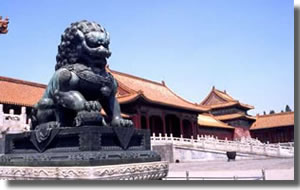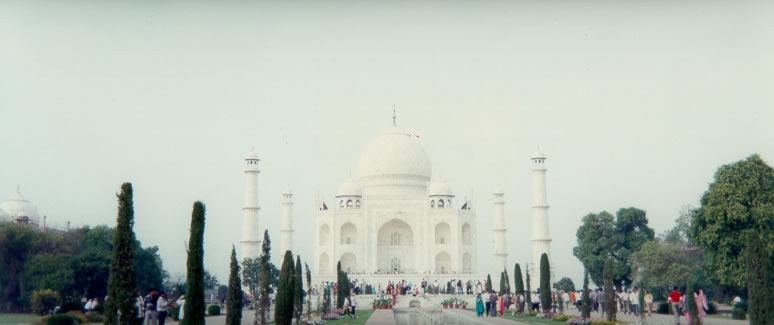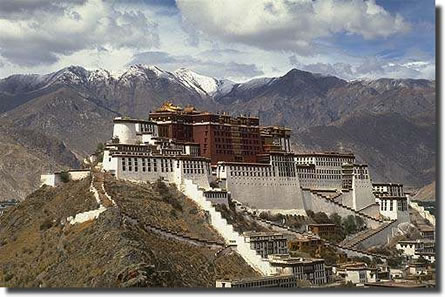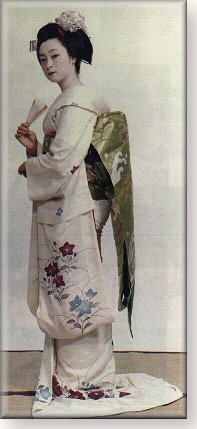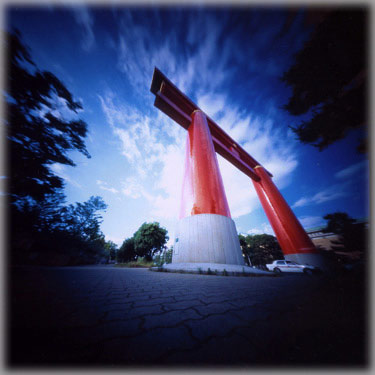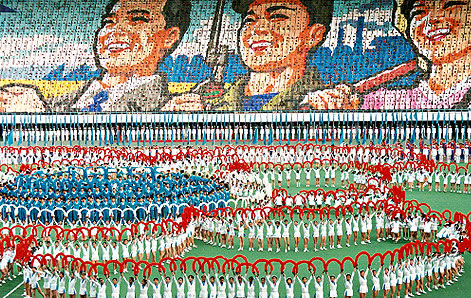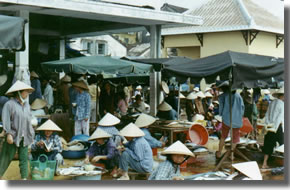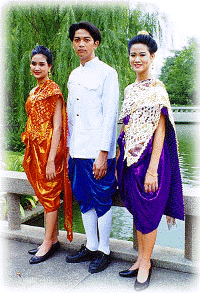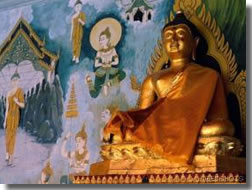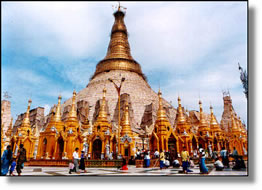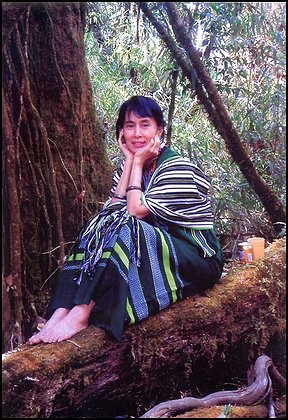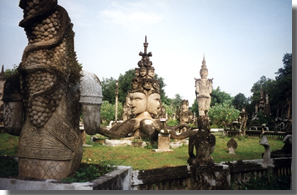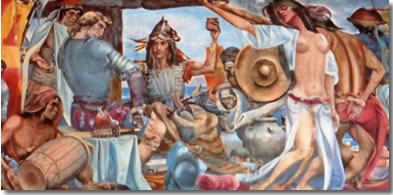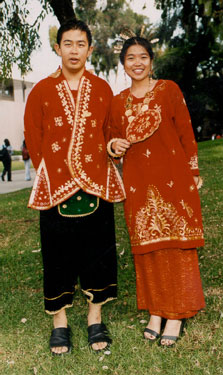Course
Objective: This course will explore the social, religious, political, economic,
and legal foundations of East and Southeast Asia. The course content is designed
to give the student a background to understand the traditions, the values and
thus the societies in East and Southeast Asia. In this course we will focus on
East and Southeast Asia.
Textbooks
required for the class: None...
All required readings will be available
online on ECR or hardcopy at the SDSU Reserve Book Room.
Readings are
taken from the following books:
Chua,
Amy. World
on Fire. New York: Doubleday, 2003
Heinz, Carolyn Brown. Asian
Cultural Traditions. Waveland Press, Inc.: Prospect Heights, 1999.
Heidhues,
Mary Somers. Southeast
Asia - A Concise History. Thames and Hudson: London, 2000.
Lowenstein,
Tom. The
Vision of the Buddha: Buddhism - The Path to Spiritual Enlightenment.
Duncan Baird Publishers: London, 1996.
Nelson, Lynn H. and Peebles, Patrick.
eds. Classics
of Eastern Thought. Harcourt Brace College Publishers: Fort Worth, 1991.
Owen,
Norman. ed. The
Emergence of Modern Southeast Asia - A New History. University of Hawaii
Press: Honolulu, 2005.
Go, Julian and Foster, Anne L. eds. The
American Colonial State in the Philippines: Global Perspectives. Duke
University Press: Durham, 2003.
McKenna, Thomas M. Muslim
Rulers and Rebels: Everyday Politics and Armed Separatism in the Southern Philippines.
University of California Press: Berkeley, 1998.
Handbook of Korea. The Korean
Overseas Information Service: Seoul, 2003.
Plus...
a new and improved "Course Pack" that I developed that is available
on ERes and Blackboard
Please
note:
(1) The tests should be taken on the assigned date and there are
no make up tests without a doctor's note.
(2) Attendance is mandatory for
this class. You risk failing the class if you miss more than four classes. If
you need to be absent from class for medical or family emergency reasons, you
are required to provide proper documentation (doctor's note or supervisor/parent
letter) to the instructor before or after class. An advanced notice is always
appreciated even under such circumstances. It is also important for you to come
to class on time and stay until the end of each session unless you have notified
me beforehand about your intention to leave class early on a particular day. I
encourage regular and active participation in the class. There will be a variety
of venues for your to participate, including commenting on the readings, and raising
questions in class. You do not need to have profound things to say every time
you raise your hand. A simple question or a short comment from you may just be
right to set a conversation going. Try to form the habit of speaking up early
in the semester. Please be attentive and respectful to your classmates when they
speak. A portion of your final grade will be based on your attendance record and
my assessment of your participation effort in class through the weekly reading
quizzes.
(3) The videos shown in class should be watched carefully as there
will be questions from them on the tests. Same goes for speakers/invited guests.
(4)
There will be no midterm or final exam so each test is of equal importance.
(5)
Missing 4 Reading Quizzes results in an automatic D in the class
(6) Missing
5 Reading Quizzes results in an automatic F in the class
Evaluations:
| 1.
Thirteen Reading Quizzes/Attendance | 03%
each | 39% |
| 2.
Four Quizzes | 10% each | 40% |
| 3.
Group Movie Project | | |
| 3.1.
Outline | 06% | |
| 3.2.
Movie Project | 15% | 21% |
| Total | | 100% |
Grade
Scale:
97 to 100
A/A+
94 to 97 A
90 to 94 A-
87 to 90 B+
84 to 87 B
80 to 84 B-
77
to 80 C+
74 to 77 C
70 to 74 C-
67 to 70 D+
64 to 67 D
60 to 64
D-
00 to 60 F
Week
1 - Jan 19
Administration, Introduction, and Examination of the Syllabus
Week
2 - Jan 22/24/26: Introduction to Asia - Geography
Course Pack 19, 2-4
Jan
22: Asia as a Cultured Space: Heinz: Chapter 1 (3-9)
Jan 24: Introduction to
Southeast Asia Heidhues: Introduction (7-15)
Jan 26: Reading Quiz 1: Please
have read Course Pack 29 to 48 and see sample questions in 31, 39-40, 48 for quiz.
Movie:
A World Without Thieves: Part 1
CHINA
AND INDIA: THE TWO PILLARS
Week
3 - Jan 29/31 and Feb 02: Confucian and Taoist China
Course Pack 5-7, 23-66
Jan
29 - Taoism
An Introduction to Taoism
http://en.wikipedia.org/wiki/Taoism
Nelson - Tao Te Ching (58-66)
Special
Guest Speaker
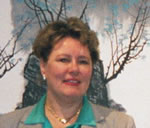 | Sandra
A. Wawrytko, Ph.D., is a member of the Philosophy Department at San Diego
State University, where she teaches classes on Asian Philosophy with an emphasis
on Daoism and Buddhism. She received her B.A. in Philosophy at Knox College and
her M.A. and Ph.D. in Philosophy at Washington University St. Louis. She has authored
and edited eight books, including The Undercurrent of 'Feminine' Philosophy in
Eastern and Western Thought and CRYSTAL: Spectrums of Chinese Culture through
Poetry. Among her other publications are numerous articles in professional journals
and chapters in scholarly books. The Asian Thought and Culture series that she
edits for Peter Lang has more than fifty volumes in print. As founder and president
of the Charles Wei-hsun Fu Foundation, a non-profit, educational foundation, she
promotes the study of Asian Thought and Culture through scholarships and other
funding. In recognition of her contributions, she has been listed in Marquis Who's
Who in America since 2004 and Who's Who in the World since 2005. Currently she
is finalizing for publication two important annotated translations done with Professor
FuÞthe Dao De Jing, The Viability and Virtuosity Classic and Wang Bi's commentary
to that text. Also in process is a volume on Enduring Daoist Wisdom: Lao Zi's
Life Lessons on Viability (Dao) and Virtuosity (De). |
Jan
31 - Confucianism
An Introduction to Confucianism
http://en.wikipedia.org/wiki/Confucianism
Nelson
- The Analects (50-56)
Feb 02 - Reeading Quiz 2: Please have read Course
Pack 20-22 & 67-76 and see sample questions in 22 & 71 for quiz.
Movie:
A World Without Thieves: Part 2
China
CIA
Factbook
Capital City: Beijing
Date of Independence: 221 BC (unification
under the Qin or Ch'in Dynasty); 1 January 1912 (Manchu Dynasty replaced by a
Republic); 1 October 1949 (People's Republic established)
Population: 1,313,973,713
(July 2006 est.)
Current Leader: President HU Jintao (since 15 March 2003)
and Vice President ZENG Qinghong (since 15 March 2003)
Type of Government:
Communist State
 Qipao Qipao | |
Week
4 - Feb 05/07/09: Buddhist China (Hinduism and Buddhism)
Feb 05 - India
(Hinduism and Buddhism)
Lowenstein (8-33)
Nelson - Sermon at the Deer Park
(30-37)
Feb 07 - Buddhism in China
An Introduction to Buddhism
http://en.wikipedia.org/wiki/Buddhism
Feb 09 - Reading Quiz 3: Please have read Heinz - Chapter 7 (246-279). Questions
will come from this literature.
Movie: Eat, Drink, Man, Woman: Part 1
India
CIA
Factbook
Capital City: New Delhi
Date of Independence: 15 August 1947
(from UK)
Population: 1,095,351,995 (July 2006 est.)
Current Leader: Prime
Minister Manmohan SINGH (since 22 May 2004)
Type of Government: Federal Republic
| 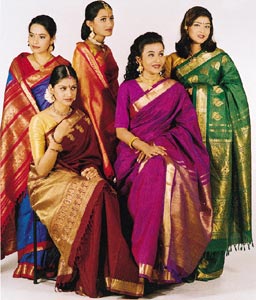 Saree/Sari Saree/Sari |
Week
5 - Feb 12/14/16: Confucianism and the Tao in Cinema
Feb 12 - China
Heinz
- Chapter 7 (246-279)
Movie: Eat, Drinnk, Man, Woman: Part 2
Taiwan
CIA
Factbook
Capital City: Taipei
Population: 23,036,087 (July 2006 est.)
Current Leader: Premier (President of the Executive Yuan) SU Tseng-chang (since
25 January 2006) and Vice Premier (Vice President of the Executive Yuan) TSAI
Ing-wen (since 25 January 2006)
Type of Government: Multiparty Democracy
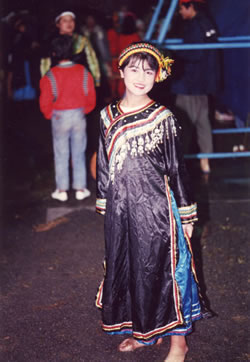
| 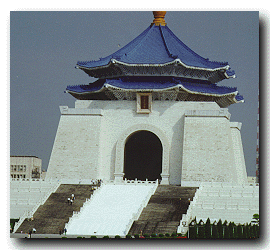
Taiwanese
Bunun Dancer
(Formosa Aborignal Dance) |
FEB
14:
QUIZ 1 - CHINA (CONFUCIANISM, TAOISM,
AND BUDDHISM)
EXAM - ALL ANSWERS FOUND IN POWERPOINTS
Feb
16 - Reading Quiz 4: Please have read Course Pack 77-80 and see sample questions
in 80 for quiz.
Movie: Barbarians - The Mongols and The Huns
THE
REST OF EAST AND CENTRAL ASIA
Week
6 - Feb 19/21/23: Mongolia
Feb 19 - The Mongol Century (Part 1)
The
Mongol Century (1-6)
http://www.geocities.com/mllora3/mongolia.htm
Feb 21
- The Mongol Century (Part 2)
The Monggol Century (7-12)
http://www.geocities.com/mllora3/mongolia.htm
Feb
23 - Reading Quiz 5: Please have read "Introduction to the Five Principal
Spiritual traditions of Tibet" for quiz.
Movie:
Tibet - Cry of the Snow Lion
Mongolia
CIA
Factbook
Capital City: Ulaanbaatar
Date of Independence: 11 July 1921
(from China)
Population: 2,832,224 (July 2006 est.)
Current Leader: Prime
Minister Miegombyn ENKHBOLD (since 25 January 2006); Deputy Prime Minister Mendsaikhan
ENKHSAIKHAN (since 28 January 2006)
Type of Government: Mixed Parliamentary/Presidential

Mongolian
Woman in Traditional Dress

| 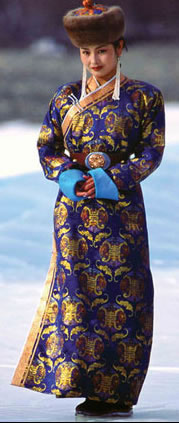 |
Week
7 - Feb 26/28/30: Tibet
Feb 26 - Everything to do with Tibet and nothing
to do with Tibet: An Examination of Ang Lee's "Chosen." Tibetan Buddhism
(An Introduction) Bonpo, Nyingma, Kahdam, Kagyu, Sakya, Gelug, Geshe Degree
Feb
28 - Tibet Today: Demystifying Tibet and the Cry of the Snow Lion - Tibetan Buddhism
(An Introduction) Bonpo, Nyingma, Kahdam, Kagyu, Sakya, Gelug, Geshe Degree
Special
Guest Speaker
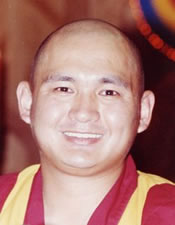 | About
Venerable Tenzin Dhonden
Monastic
Affiliation and Training Namgyal Monastery, Personal Monastery of His Holiness
the Dalai Lama, McLeod Ganj, Dharamsala - 176219, Kangra Distt., H.P. India
Religious
and Philosophical Training Member of Namgyal Monastery since the age of eight.
Curriculum included four years of memorizing Tibetan canonical literature, philosophical
and tantric texts including Guyasamaja, Chakrasambhava, Yamantaka, and Kalachakra
Tantras, as well as other Tibetan texts that are based on offering or inviting
the Dharma protectors. Thirteen years of study were devoted to the study of collective
topics on logic, Buddhist inner science, Buddhist psychology, the four schools
of Buddhist philosophy, and the four great tantric philosophies, such as action,
kriya, yoga, and highest yoga tantras.
Artistic
Training and Experience Mastery of the art of creating sand mandalas or paintings,
and butter sculptures according to the Tibetan Buddhist tradition as well as Buddhist
ritual dances including the Black Hat dance, Kalachakra dance, Deer dance, and
Dances of the Diamond Realm. |
Feb
30 - Reading Quiz 6: Please have read Course Pack 107-122 and see sample questions
in 108 for quiz.
Movie: Japan: Memoirs of a Secret Empire - Part 1: The
Way of the Samurai
Tibet
Factbook
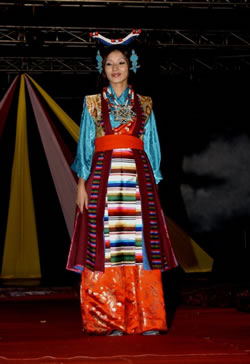 In
traditional Custom from Central Tibet In
traditional Custom from Central Tibet | |
Week
8 - Mar 5/7/9: Japan
Mar 05 - Introduction to Tokugawa Japan: The Seeds
of "Japanese" Identity Tokugawa Japan: The Social and Economic Antecedents
of Modern Japan (11-36)
Special Guest
Speaker
 | Dustin
Wright, M.A., recently obtained his Master's from the Department of Asia Pacific
Studies at SDSU, having written a thesis entitled "Political Atrocity: The
Role of the Nanjing Massacre in Contemporary Sino-Japanese Relations." His
academic interests include modern Japanese history, international politics, race
and migration, and economic development. He currently works for a San Diego-based
NGO and is a fan of coffee shops in Normal Heights, miso ramen, and flight coupons.
Dustin, always enthusiastic about a good chat, can be reached at dwright@projectconcern.org.
|
Mar 07 - Introduction
to Meiji Japan through an examination of The Last Samurai... Please make sure
to watch the movie prior to coming to class, as I will not summarize it... The
movie is on reserve for the class and the code is: DVD 713 ... and Shinto and
Buddhism in Japan
An Introduction to Shinto: Heinz - Chapter 8 (311-327)
http://en.wikipedia.org/wiki/Shinto
Mar
09 - Reading Quiz 7: Please have read Handbook of Korea (424-443) for quiz.
Movie:
A State of Mind
Japan
CIA
Factbook
Capital City: Tokyo
Date of Independence: 660 B.C. (traditional
founding by Emperor JIMMU)
Population: 127,463,611 (July 2006 est.)
Current
Leader: Chief of State: Emperor AKIHITO (since 7 January 1989)
Head of Government:
Prime Minister Shinzo ABE (since 26 September 2006)
Type of Government: Constitutional
Monarchy with a Parliamentary Government

The
Woodblock Prints of Ando Hiroshige
The 53 Stations of the Tokaido Road
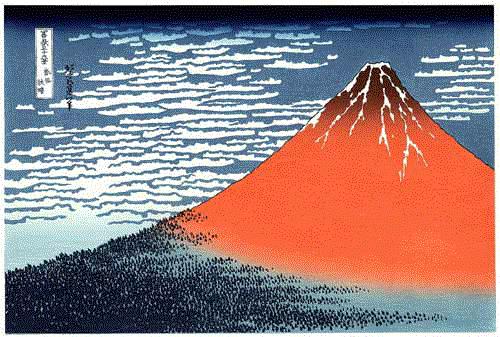
24
Views of Mount Fuji
Hokusai Katsushika (1760-1849)
Yoshiwara
was not the Gion!
Week
9 - Mar 12/14/16: Korea
Mar 12 - Modern History
Handbook of Korea (91-115),
Handbook of Korea (424-443)
Korea,
North
CIA
Factbook
Capital City: Pyongyang
Date of Independence: 15 August 1945
(from Japan)
Population: 23,113,019 (July 2006 est.)
Current Leader: KIM
Jong Il (since July 1994); note - on 3 September 2003
Type of Government: Communist
State One-Man Dictatorship
|  Hanbok Hanbok |
Korea,
South
CIA
Factbook
Capital City: Seoul
Date of Independence: 15 August 1945 (from
Japan)
Population: 48,846,823 (July 2006 est.)
Current Leader: chief of
state: President ROH Moo-hyun (since 25 February 2003)
head of government:
Prime Minister HAN Myeong-sook (since 20 April 2006)
Type of Government: Republic
 | 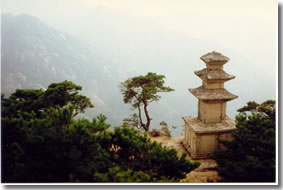 Hanbok Hanbok |
MAR
14:
QUIZ 2 - EAST ASIA: MONGOLIA, TIBET,
JAPAN, KOREA
EXAM - ALL ANSWERS FOUND IN POWERPOINTS
GROUP
MOVIE PROJECT OUTLINE DUE MAR 14, 2007
Mar
16 - Reading Quiz 8: Please have read Southeast Asia: The Big Picture Heidhues
- 68-75 for quiz.
Movie: The Scent of Green Papaya: Part 1
MAINLAND
SOUTHEAST ASIA
Week
10 - Mar 19/21/23: An Introduction to the Mainland Southeast Asian Region of Burma/Cambodia/Thailand/Vietnam/Laos
Mar
19 - Southeast Asia: The Big Picture Heidhues - 68-75 and Chua 23-48
Movie:
Southeast Asia: The People
Mar 21 - Spread of Buddhism (Theravada) and the
Indian Legacy
Mar 23 - Reading Quiz 9: Please have read Vietnam, 1700-1885:
Disunity, Unity, and French Conquest in Modern Southeast Asia (106-116) and Cambodia,
1796-1885:Politics in a Tributary Kingdom in Modern Southeast Asia (117-122) for
quiz.
Movie: The Scent of Green Papaya: Part 2
Week
11 - Apr 2/4/6: Vietnam and Cambodia
Apr 2 - Vietnam
Vietnam, 1700-1885:
Disunity, Unity, and French Conquest in Modern Southeast Asia (106-116)
Vietnam
CIA
Factbook
Capital City: HANOI
Date of Independence from France: Date:
02 Septmber 1945
Population: 84, 402, 966
Current Leader: President Truong
My Hoa
Type of Government: Communist State
| 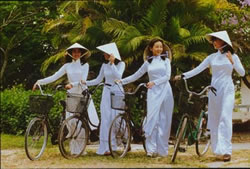 Ao
Dai Ao
Dai |
Apr 4 -
Cambodia
Cambodia, 1796-1885:Politics in a Tributary Kingdom in Modern Southeast
Asia (117-122)
Apr 6 - Reading Quiz 10: Please have read Myanmar Becomes British
Burma in Modern Southeast Asia (83-92) and Siam: From Ayutthaya to Bangkok in
Modern Southeast Asia (93-105) for quiz.
Movie: Raise the Bamboo Curtain:
Part 1
Cambodia
CIA
Factbook
Capital City: PHNOM PENH
Date of Independence from France:
Date: 09 November 1953
Population: 13, 881, 427
Current Leader: Prime Minister
Hun Sen
Type of Government: Multiparty Democracy under a Constitutional Monarchy
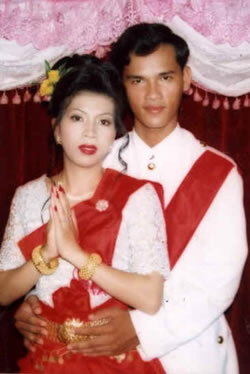
The
traditional Khmer costume consisted of a shirt or blouse and a skirt-like lower
garment: sampot for women and sarong for men, a tube-shaped garment
about a meter wide and as much as three meters in circumference.
| 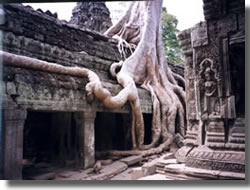
Made
of cotton or of silk in many different styles and patterns, it is pulled on over
the legs and fastened around the waist. On ceremonial occasions, elegant sampot
as sarong, embroidered with gold or silver threads, may be worn with a long piece
of material gathered at the waist, passed between the legs, and tucked into the
waistband in back. Members of the urban middle
and upper classes may wear Westernstyle clothing at work and more traditional
clothing at home. 
|
Week
12 - Apr 9/11/13: Thailand and Burma
Apr
9 - Thailand
Siam: From Ayutthaya to Bangkok in Modern Southeast Asia (93-105)
Thailand
CIA
Factbook
Capital City: BANGKOK
Date of founding: 1238 (traditional founding
date: never colonized)
Population: 64, 631, 595
Current Leader: Interim
Prime Minister Surayut Chulanon
Type of Government: Constitutional Monarchy
Special
Guest Speaker
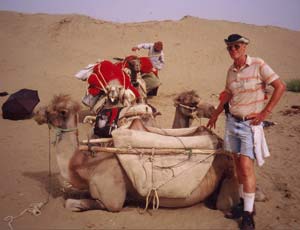 | Biographical
Information: While pursuing his degrees, he lived and carried out research
in Taiwan, Japan, and Germany. Upon completion of his final degree, Dr. Wittenborn
took three months driving the "Overland India" route from London to
New Delhi, India, including a two-week stay in Afghanistan. Dr. Wittenborn first
turned to business and became a private entrepreneur in the travel and tourism
field. This led him to start his own company which required extensive travel in
Asia throughout the 1980s, including a two-year residence aboard a Yangtze River
cruise ship in China. Since 1988, Dr. Wittenborn has been fully engaged in university
teaching and research. He has taught at Hawaii Pacific College in Honolulu, and
locally at UC San Diego, Cal State San Marcos, and the University of San Diego.
B.A.,
Chinese & Japanese Literaure, San Francisco State University; M.A., International
Relations, University of Oregon; Ph.D., Asian Studies, University of Arizona;
SDSU faculties of Asian Studies and History
Scholarly Interests: Neo-Confucianism,
Traditional and Modern Southeast Asia, Indonesia, Burma and Malaysia, Trade and
Development in the Indian Ocean, Human Rights in Asia
Research: Arab-Chinese
wars of the Tang Dynasty, Malay-Chinese and Muslim-Christians Conflicts in Indonesia,
The role of the CIA in Chinese Nationalist Armies in Burma |
Apr
11 - Burma
Myanmar Becomes British Burma in Modern Southeast Asia (83-92)
Burma
CIA
Factbook
Capital City: RANGOON
Date of Independence from Great Britain:
Date: 4 January 1948
Population: 47, 382, 633
Current Leader: Prime Minister
Gen Soe Win
Type of Government: Military Junta
Apr
13 - Reading Quiz 11: Please have read Laos to 1975 in Modern Southeast Asia (371-375)
for quiz.
Movie: Raise the Bamboo Curtain: Part 2
Week
13 - Apr 16/18/20: Laos
Apr 16 - Laos
Laos to 1975 in Modern Southeast
Asia (371-375)
Laos
CIA
Factbook
Capital City: VIENTIANE
Date of Independence from France: Date:
19 July 1949
Population: 6, 368, 481
Current Leader: Prime Minister Bouasone
Bouphavanh
Type of Government: Communist State
|
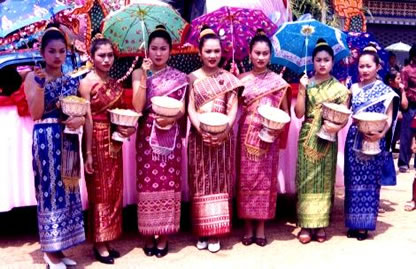
Dress
for a ceremonial precession |
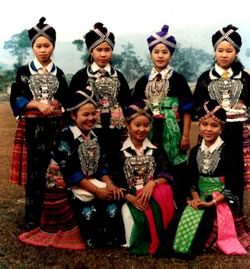
Hmoung
Lai |
APR
18:
QUIZ 3 - VIETNAM/ CAMBODIA/ BURMA/
THAILAND/ LAOS
EXAM - ALL ANSWERS FOUND IN POWERPOINTS
Apr
20 - Reading Quiz 12: Please have read Inheriting the "Moro Problem":
Muslim Authority and Colonial Rule in British Malaya and the Philippines in The
American Colonial State in the Philippines (118-147) and Becoming Indonesia 1900-1959
(296-311) for quiz.
Movie: Rizal: Part 1
MARITIME
SOUTHEAST ASIA
Week
14 - Apr 23/25/27: The Maritime Region: Indonesia/Malaysia/Philippines/Singapore/Brunei
The
juxtaposition of Christianity and Islam in Southeast Asia: Philippines and Indonesia
Apr
23 - Philippines
Islam in a Christian State
Muslim Separatism and the Bangsamoro
Rebellion in Muslim Rulers and Rebels (138-169)
Inheriting the "Moro Problem":
Muslim Authority and Colonial Rule in British Malaya and the Philippines in The
American Colonial State in the Philippines (118-147)
Philippines
CIA
Factbook
Capital City: MANILA
Date of Independence from United States
of America: Date: 04 July 1946
Population: 89, 468, 677
Current Leader:
President Gloria Macapagal-Arroyo
Type of Government: Republic
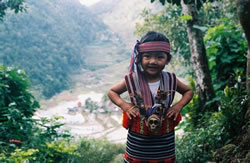
Ifugao
Traditional Dress
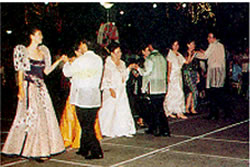
The
Maria Clara and Barong Tagalog
| |
Apr
25 - Indonesia
Becoming Indonesia, 1900-1959 in Modern Southeast Asia (296-311)
Apr
27 - Reading Quiz 13: Please have read Singapore and Brunei in Modern Southeast
Asia (422-430) for quiz.
Movie: Rizal: Part 2
Indonesia
CIA
Factbook
Capital City: JAKARTA
Date of Independence from The Netherlands:
Date: 17 August 1945
Population: 245, 452, 739
Current Leader: President
Susilo Bambang
Type of Government: Republic
| 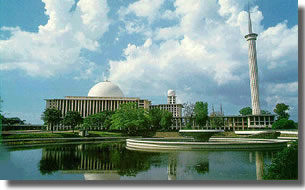
Indonesian
National Dress

|
Week
15 - Apr 30 and May 2/4: Malaysia, Singapore, and Brunei
Apr 30 - Malaysia
The
Malay Negeri of the Peninsula and Borneo in Modern Southeast Asia (137-146)
Malaysia
CIA
Factbook
Capital City: KUALA LUMPUR
Date of Independence from Great
Britain: Date: 31 August 1957
Population: 24, 385, 858
Current Leader: Prime
Minister Abdullah bin Ahmad Badawi
Type of Government: Constitutional Monarchy
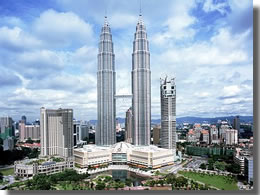
On
ceremonial occassions, the men wear the Baju Melayu consisting of a loose shirt
and a pair of long trousers. A sarung known as sampin is wrapped around the waist
and is left to hang half-way over the trousers. The headgear consists of a black
fez-like cap known as a songkok, whereas on grander ocassions, a tanjak or tengkolok
is donned.

| 
Baju
Kurung
The women usually wear baju kurung consisting of a loose-fitting
blouse and a sarung; or the baju kebaya, a tight-fitting blouse and sarung.
|
May
2 - Singapore/Brunei
Singapore and Brunei in Modern Southeast Asia (422-430)
Culture
Is Destiny - A Conversation with Lee Kuan Yew
Is Culture Destiny? The Myth
of Asia's Anti-Democratic Values - Kim Dae Jung
May 4 - No Reading Quiz but
review for last Quiz
Movie: Big Business and the Ghost of Confucius
Singapore
CIA
Factbook
Capital City: SINGAPORE
Date of Independence from Malaysian
Federation: Date: 09 August 1965
Population: 4, 492, 150
Current Leader:
Prime Minister Lee Hsien Loong
Type of Government: Parliamentary Republic 
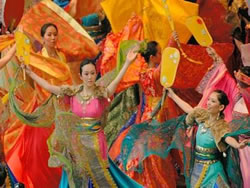
People
of Singapore
| Brunei
CIA
Factbook
Capital City: BANDAR SERI BEGAWAN
Date of Independence from
Great Britain: Date: 01 January 1984
Population: 379, 444
Current Leader:
Sultan and Prime Minister Sir Hassanal Bolkiah
Type of Government: Constitutional
Sultanate 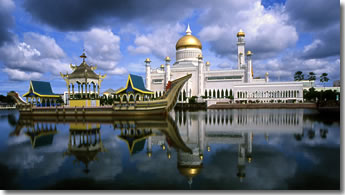
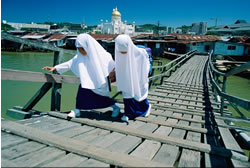
Children
in Brunei
|
Week
16 - May 7:
MAY
7:
QUIZ 4 - PHILIPPINES/MALAYSIA/SINGAPORE/BRUNEI
DARUSSALAM/INDONESIA
EXAM - ALL ANSWERS FOUND IN POWERPOINTS
GROUP
MOVIE PROJECT DUE MAY 7, 2007
FINALS
WEEK - FREE
All
maps are referenced to and are from the CIA Factbook of each country
Film
Research Tips for AS101
From
Pamela Jackson
Information Literacy Librarian
 Finding Full Text Articles
Finding Full Text Articles
Journal
Article Databases
The following databases are a good place to start for
journal articles.
Try searching by the title of the film, the director, or
a combination.
There may be some films for which you do not find relevant
articles for your research (or for which you only find reviews of the film).
Tips
for tackling research when not much has been written on a specific film include:
*
See if there's any overall research about the director. This may lead to scholarly
information about common themes used by the director that the student can then
apply to an analysis of the film.
* See if there are resources that discuss
the themes in Asian Cinema. Although the resource may not mention the chosen film
in particular, students can apply what is said about the theme, films, and Asian
culture to their analysis.
Databases
can be accessed from the Library's webpage at: http://infodome.sdsu.edu/research/databases/databases.shtml
* Film Literature Review (you can search by production title
or person. You may also filter the search results to find articles only and weed
out film reviews).
* Humanities Citation Index and Social Science Citation
Index can be searched simultaneously via Web of Science.
* MLA
International Bibliography
* You may also find articles in Proquest
or Academic Search Premiere.
Books
Try
searching the Library Catalog (http://libpac.sdsu.edu/)
for Asian Cinema (or any specific culture and cinema, e.g. Chinese Cinema, Japanese
Cinema, Korean Cinema, etc) or by the title of the film, the director or a lead
actor.
Get started early
on your book research!
Film is a popular area of study and the books are
heavily used.
If a book you need is not owned by SDSU, checked out, or missing
from our collection, you may request it from another library.
Here are the
options (http://illiad.sdsu.edu/illiad/about/index.html):
*
Circuit is a collaboration between SDSU, UCSD, USD and CSUSM. Books requested
via Circuit usually arrive at our circulation desk within one day.
* Link+
is a collaboration of libraries across California and parts of Nevada. Books requested
usually arrive at SDSU in about 3 days.
* Interlibrary Loan is a collaboration
of libraries worldwide. It may take up to 2 weeks for books to arrive.
Film
Research Guide
http://infodome.sdsu.edu/research/guides/filmcriticism.shtml
Remember,
you can always visit the librarians at the reference desk under the dome for research
help or with using a database!
More...
Citing
Lectures
Due to popular demand, here is the MLA format for citing lectures:
Lecturer's
name. "Title of lecture." Meeting. Name of sponsoring organization.
Location of lecture, date.
Note: If you do not know the title of the lecture,
or the lecture does not have a title, simply write "lecture" or "address."
(Without the quotation marks, of course.)
Examples:
Litfin, Karen. "Introduction
to Political Economy." Political Science 203. University of Washington. Seattle,
16 October 2000.
LaVaque-Manty, Mika. "Gendered Citizenship Revisited."
Political Science 318. University of Washington. Seattle, 16 October 2000.
In
partnership with 
page last updated 1 March 2007
Copyright © 2006 Miguel B. Llora, MA. All
Rights Reserved.
Best viewed on Internet Explorer 5.x or later at a minimum
of 1024 x 768 resolution
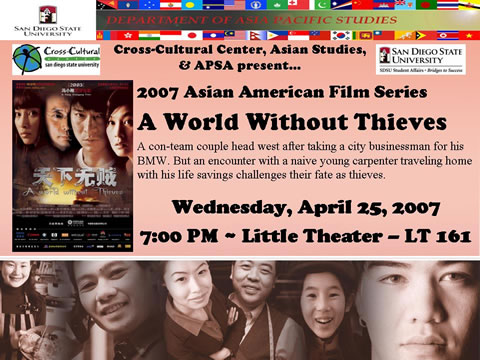


 AS101 Spring 2007 - Syllabus
AS101 Spring 2007 - Syllabus AS101 Spring 2007 -
Group Movie Project
AS101 Spring 2007 -
Group Movie Project


